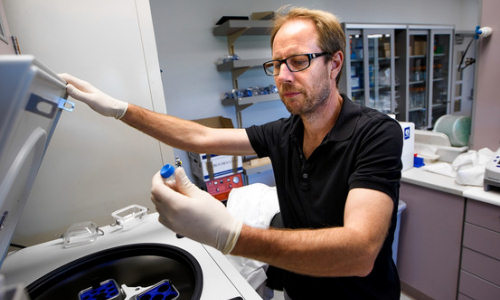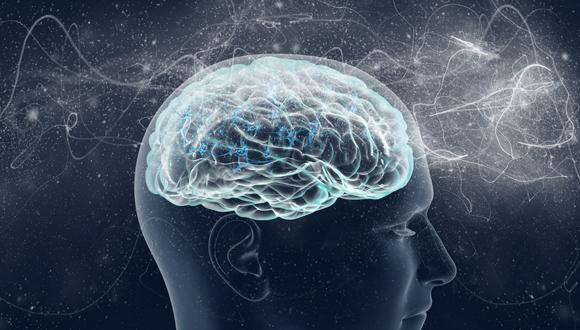Something — or some things — in the blood of young mice has the ability to restore mental capabilities in old mice, a new study by Stanford University School of Medicine investigators has found.
Wyss-Coray and his collaborators are working to discover the specific factors in the blood of young mice that can recharge the brain of an old mouse.
If the same goes for humans, it could spell a new paradigm for recharging our aging brains, and it might mean new therapeutic approaches for treating dementias such as Alzheimer’s disease.
In the study, published online May 4 in Nature Medicine, the researchers used sophisticated techniques to pin down numerous important molecular, neuroanatomical and neurophysiological changes in the brains of old mice that shared the blood of young mice.
But they also conducted a critical experiment that was far from sophisticated, said Tony Wyss-Coray, PhD, the senior author of the study and a professor of neurology and neurological sciences. The scientists simply compared older mice’s performance on standard laboratory tests of spatial memory after these mice had received infusions of plasma (the cell-free part of blood) from young versus old mice, or no plasma at all.
“This could have been done 20 years ago,” said Wyss-Coray, who is also senior research career scientist at the Veterans Affairs Palo Alto Health Care System. “You don’t need to know anything about how the brain works. You just give an old mouse young blood and see if the animal is smarter than before. It’s just that nobody did it.”
Wyss-Coray has co-founded a biotechnology company, Alkahest, to explore the therapeutic implications of the new study’s findings. He serves as the director of Alkahest’s scientific advisory board.
The study’s lead author, Saul Villeda, PhD, now has an active lab of his own as a faculty fellow in anatomy at the University of California-San Francisco. Villeda was a graduate student at Stanford and, briefly, a postdoctoral scholar under Wyss-Coray’s direction when the bulk of the work was performed.
Reversing impairments
“We’ve shown that at least some age-related impairments in brain function are reversible. They’re not final,” Villeda said.
Previous experiments by Wyss-Coray, Villeda and their colleagues, described in a paper published in 2011 in Nature, had revealed that key regions in the brains of old mice exposed to blood from young mice produced more new nerve cells than did the brains of old mice similarly exposed to blood from old mice. Conversely, exposing young mice to blood from old mice had the opposite effect with respect to new nerve-cell production, and also reduced the young mice’s ability to navigate their environments.
But that earlier work didn’t directly assess the impact of young mouse blood on older mice’s behavior. This time, the researchers checked both for changes within nerve circuits and individual nerve cells and for demonstrable improvements in learning and memory. First, they examined pairs of mice whose circulatory systems had been surgically conjoined. Members of such pairs, known as parabiotic mice, share a pooled blood supply.
Wyss-Coray’s group paid special attention, in these parabiotic mice, to a brain structure called the hippocampus. In both mice and humans, this structure is critical for forming certain types of memories, notably the recollection and recognition of spatial patterns. “That’s what you need to use when, for example, you try to find your car in a parking lot or navigate around a city without using your GPS system,” Wyss-Coray said.
Experience alters hippocampal activity and anatomy. Studies have found, for instance, that a veteran London cabdriver’s hippocampus is larger than it was when the driver was first hired, and larger than the average person’s. The hippocampus is also extremely vulnerable to the normal aging process, showing early erosion in function as people grow older. In dementias such as Alzheimer’s disease, this hippocampal deterioration is accelerated, leading to an inability to form new memories.
“We know that detrimental anatomical and functional changes occur in the hippocampus as mice and people get older,” said Villeda. “This is just from natural aging. We’re all heading in that direction.”
When the investigators compared hippocampi from old mice whose circulatory systems had been conjoined with those of young mice to hippocampi from old mice that had been paired with other old mice, they found consistent differences in a number of biochemical, anatomical and electrophysiological measures known to be important to nerve-cell circuits’ encoding of new experiences for retention in the cerebral cortex.
Recharging old brains
The hippocampi of older mice that had been conjoined to younger mice more closely resembled those of younger mice than did the hippocampi of older mice similarly paired with old mice. The old mice paired with young mice made greater amounts of certain substances that hippocampal cells are known to produce when learning is taking place, for example. Hippocampal nerve cells from older members of old-young parabiotic pairs also showed an enhanced ability to strengthen the connections between one nerve cell and another — essential to learning and memory.
“It was as if these old brains were recharged by young blood,” Wyss-Coray said.
Villeda, Wyss-Coray and their associates next subjected regular older mice to a test in which the mice were trained to quickly locate a submerged platform in a water-filled container. The mice had to speedily orient themselves using memory cues provided by their surroundings. The investigators injected old mice intravenously with plasma from young or old mice and ran them through the test. Typically, untreated older mice did poorly compared to young mice, as they did when injected with plasma from old mice. But if they were infused with young mice’s plasma they did much better.
This was likewise the case on another test in which mice were trained to freeze in fear when plunked into a particular environment. The better they recognized that environment, the longer they would freeze. Older mice typically freeze for a shorter period of time than younger ones do. Again, “freezing” times for older mice given young plasma, but not old plasma, increased significantly.
Finding the factors
In both tests, the improvement vanished if the plasma provided to the old mice had first been subjected to high temperatures. Heat treatment can denature proteins, so this hints that a blood-borne protein, or group of them, may be responsible for the cognitive improvements seen in old mice given young mouse plasma.
“There are factors present in blood from young mice that can recharge an old mouse’s brain so that it functions more like a younger one,” Wyss-Coray said. “We’re working intensively to find out what those factors might be and from exactly which tissues they originate.”
“We don’t know yet if this will work in humans,” he said, adding that he hopes to find out sooner rather than later. A near-term goal of his company is to test this proposition through a clinical trial.
Story Source:
The above story is based on materials provided by Standford University, Bruce Goldman.





